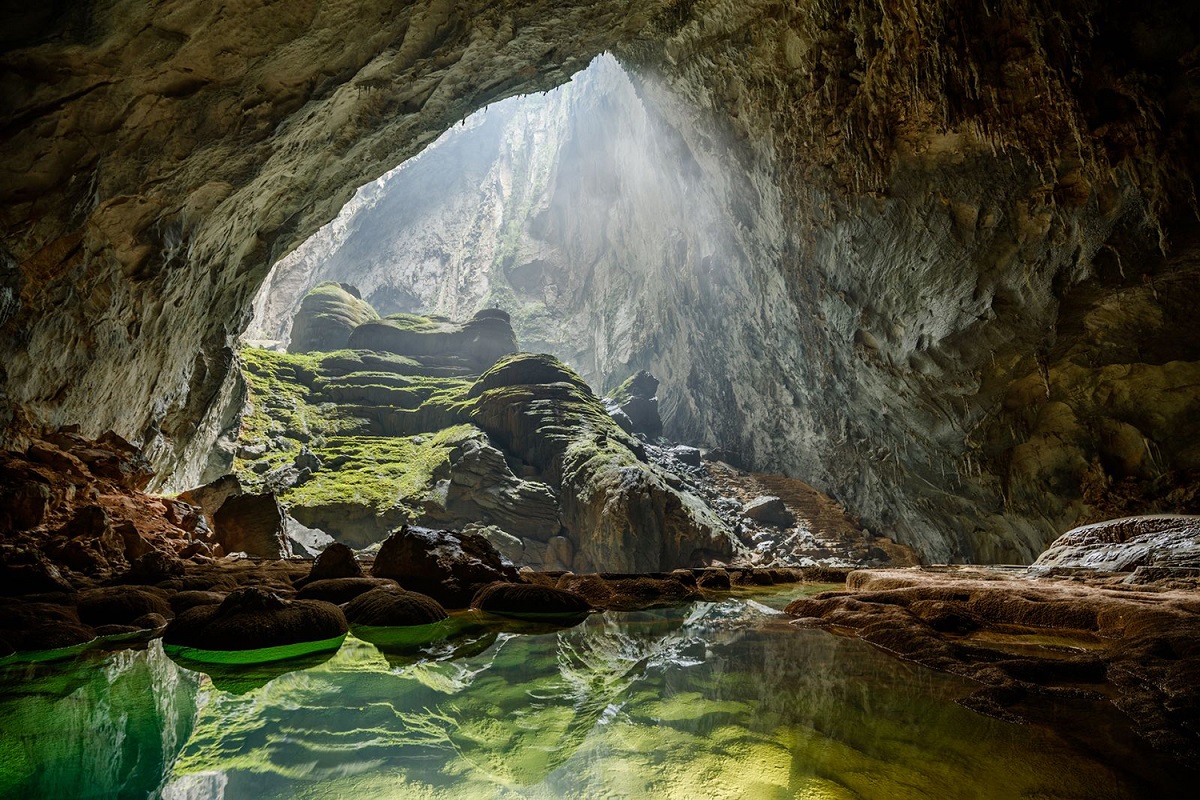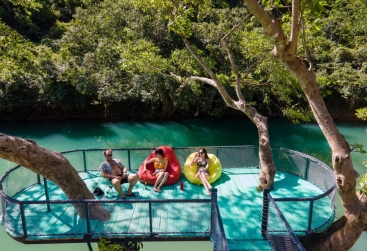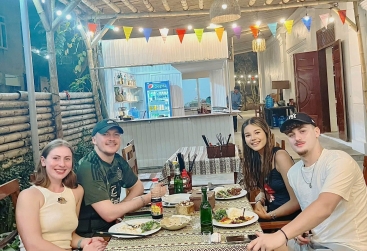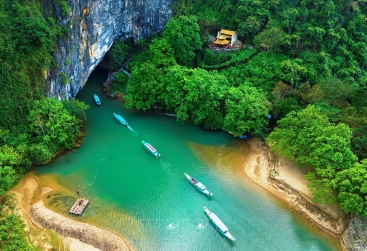GEOGRAPHY
Location and area
The province occupies coordinates 16°55’ to 18°05’ North and 105°37’ to 107°00’ East. It borders Hà Tĩnh province on the north with the Ngang mountain pass as the natural frontier, Quảng Trị province to the south, Laos to the west, and faces the Dong Sea to the east. The narrowest part from east (seaside) to west (Laotian border) is just 40 km. The provincial topography is characterized by a general slope, higher in the west and lower in the east, with hilly and mountainous areas accounting for 85% of the total area. The Annamite Range is the natural border between Quảng Bình province and Laos with peaks ranging from 1,000 to 1,500 m, the summit of which is peak Phi Co Pi with a height of 2,017 m. In the east of the province are lower hills and then several narrow plains and river deltas. The seaside sand dunes belt is a natural dam that protects the land from the ocean tides.
The provincial land area is 8,037.9 km2 and is divided as follows:
Inhabited land: 41.45 km2
Agriculture: 1635.46 km2
Forest: 4912.62 km2
Specific usage: 199.36 km2
Unused: 26.01 km2
Sand area accounts for 5.9% of the land, and alluvial soil accounts for only 2.8% of the land. The province's east coastline is 116.04 km long and the western borderline with Laos is 201.81 km long. The province owns 4866.88 km2 of forests, of which 4478.37 km2 is natural jungle, and 388.54 km2 is reforestation (including 175.97 km2 of pines).[5][6]
The province is located at the coordinates:
The northernmost point: 180 5'12" N
The southernmost point: 170 5'02" N
The westernmost point: 106 59'37" E
The westernmost point: 105 36'55" E
The coastline is 116.04 km on the east, the borderline with Laos is 201.87 km on the west.
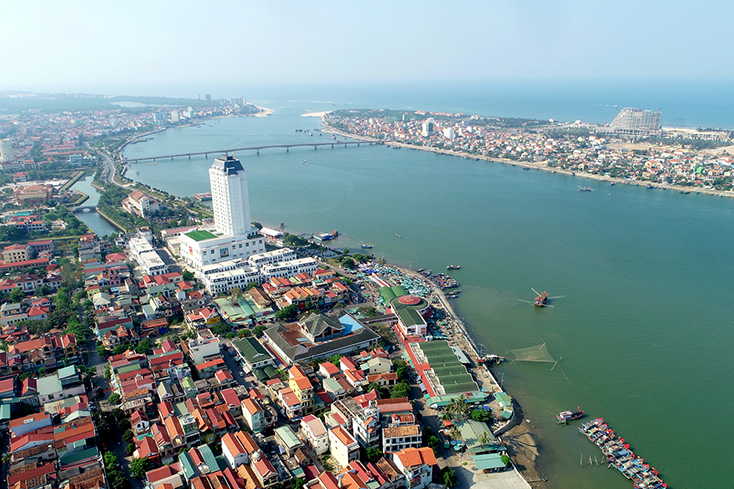
Rivers and sea
Nhật Lệ River, Quảng Bình province
Bang Spa in Lệ Thủy District
Vung Chua Beach in Quảng Bình
There are five major rivers in this province, as follows:
Gianh River (this historic river used to be the border splitting Vietnam into two countries during the Trịnh–Nguyễn War)
Ron River
Nhật Lệ River (the confluence of the Kiến Giang and Long Đại rivers)
Ly Hoa River
Dinh River
Kiến Giang River, Lệ Thủy District
Son River, Phong Nha-Kẻ Bàng
Most of the rivers originate in the Truong Son Range and empty into the Sea. River and stream density is 1.1 km/km2. There are some 160 natural and man-made lakes with total water deposit of 234.3 million cubic meter of fresh water, Quảng Bình Province's sea area includes continental shelf and special economic area up to 20,000 km2. Off the sea, there lie Hòn La islet, Hòn Gió islet, Hòn Nồm islet, Hòn Cỏ islet, Hòn Chùa islets with the total fishery capacity of 100,000 metric tonnes. Hòn La bay is a 4-square-km marine bay with the depth up to 15 m and a surrounding land of 4 km2 suitable to develop sea deep-water port and industrial park.
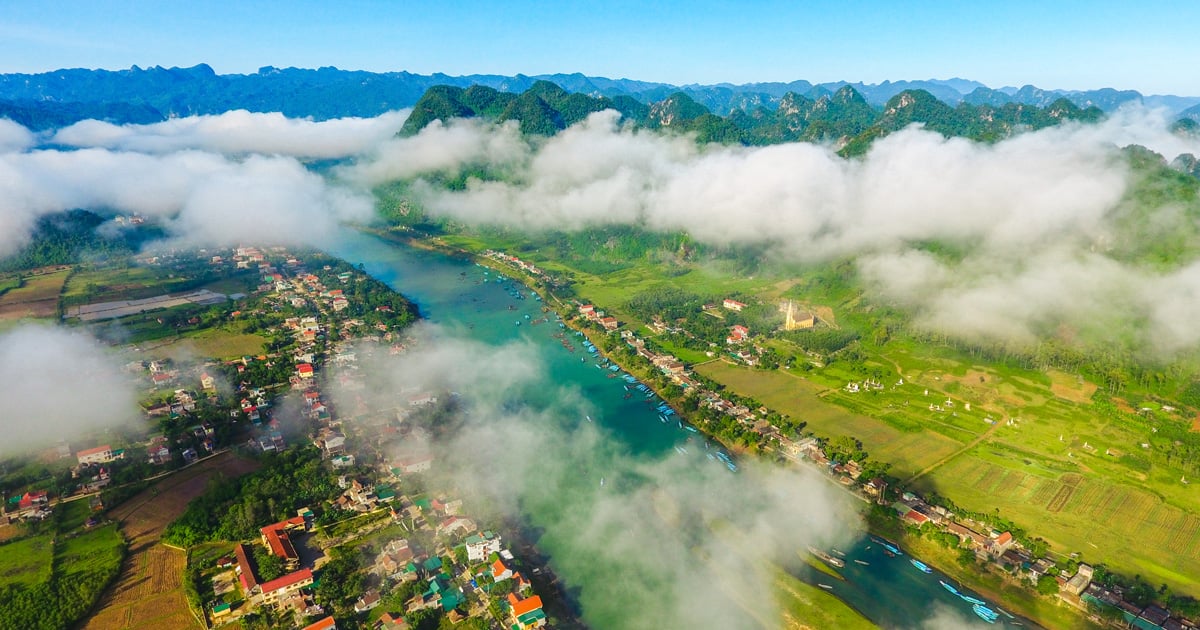
Mountains:
The Hoành Sơn Mountains run through the northeastern part of the province.
Many mount summits are concentrated in Phong Nha-Kẻ Bàng area with over 1,000 meters in height. Noteworthy peaks are the Peak Co Rilata with a height of 1,128 m and the Peak Co Preu with a height of 1,213 m.[7] Mountains in the karstic area of the park rise at a typical height of above 800 m and constitute a continuous range along the Laotian-Vietnamese borderline, of which notable summits above 1000m are: Phu Tạo (1174m), Co Unit (1150m), Phu Canh (1095m), Phu Mun (1078m), Phu Tu En (1078m), Phu On Chinh (1068m), Phu Dung (1064m), Phu Tu Ôc (1053m), Phu Long (1015m), Phu Ôc (1015m), Phu Dong (1002m). Inserting into these summits are 800–1000 m high summits of Phu Sinh (965m), Phu Co Tri (949m), Phu On Boi (933m), Phu Tu (956m), Phu Toan (905m), Phu Phong (902m), and Ma Ma (835m).
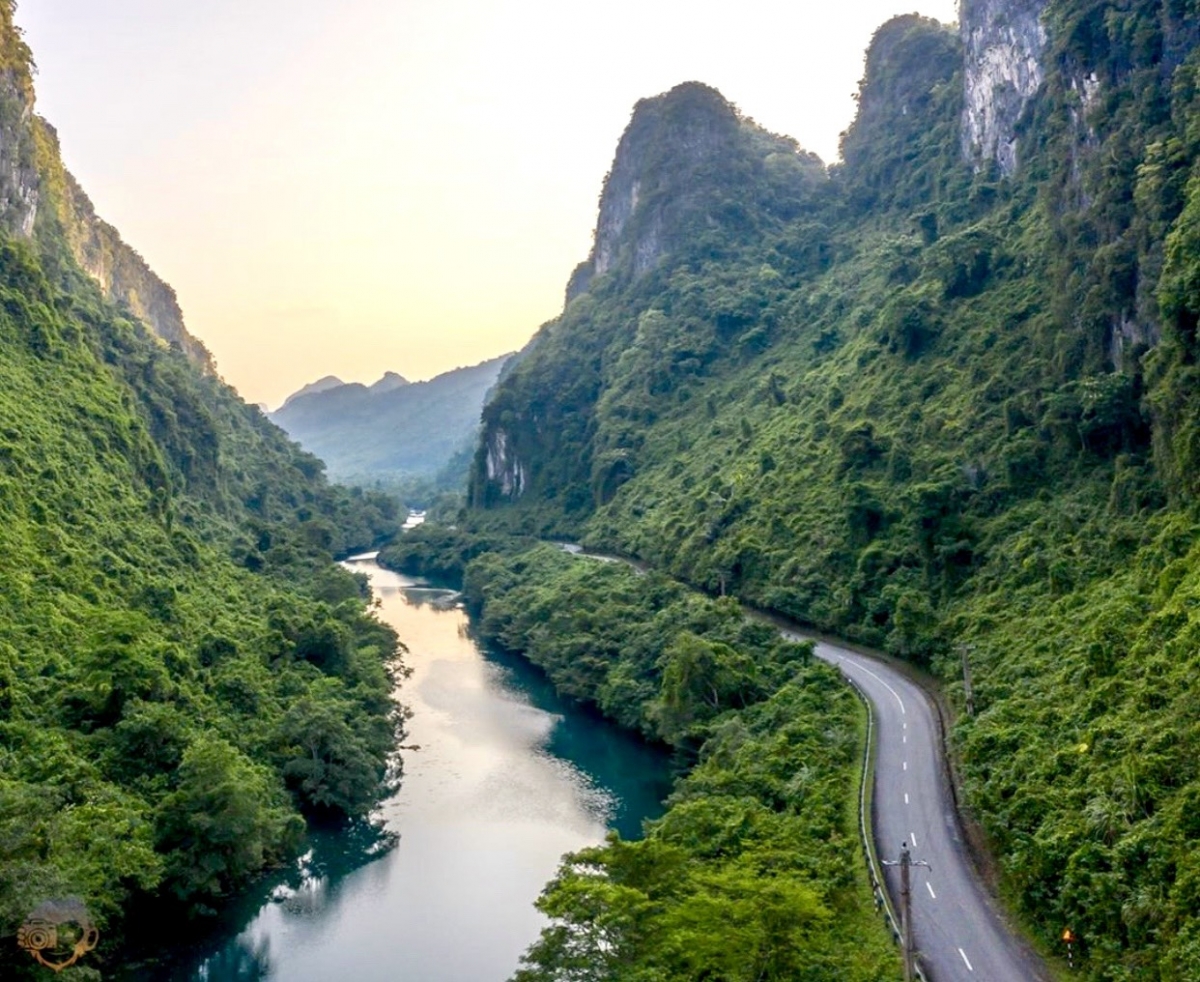
Climate in Quang Binh
There are four separate seasons here: in spring (from February to April), it is warm with slight rains, humid and the temperature around 18 to 25 degrees Celsius. In the summer (from May to July), it is hot, dry with little downpours, the temperature may reach up to 35 to 36 degrees Celsius. In the fall, it is rainy, cool with temperatures around 22 to 28 degrees Celsius. In the winter, it is humid, slight rain with temperature about 12 to 16 degrees Celsius. Annual average precipitation is around 2,000-2,300 mm. The heaviest rainy season is from September to November. From April to August is the dry season. The hottest months are from June to August.
BIODIVERSITY
Quảng Bình province is endowed with biodiversity, especially typical of Annamites eco-region. According to the results of initial surveys, the primary tropical forest in Phong Nha-Kẻ Bàng is home to 140 families, 427 genera, and 751 species of vascular plants, of which 36 species are considered endangered and listed in the Vietnam's Red Data Book. The most common tree species in this park are Hopea sp., Sumbaviopsis albicans, Garcinia fagraeoides, Burretiodendron hsienmu, Chukrasia tabularis, Photinia arboreum and Diospyros salletii. Seedlings can only grow in holes and cracks in the limestone where soil has accumulated, so in general regeneration after disturbance is slow. The forest type in this national park is dominated by evergreen tree species with scattered deciduous trees such as Dipterocarpus kerri, Anogeissus acuminata, Pometia pinnata and Lagerstroemia calyculata. In Phong Nha-Kẻ Bàng, the dominant plant families are the Lauraceae, Fabaceae, Theaceae and Rosaceae, with some scattered gymnosperms such as Podocarpus imbricatus, Podocarpus neriifolius, and Nageia fleuryi.
In the national park there is a 5000-ha forest of Calocedrus macrolepis on limestone (Calocedrus rupestris) mounts with about 2,500 trees, 600 per hectare. This is the largest forest of this tree in Vietnam. Most of these trees here are 500–600 years old. These trees are listed in group 2A (rare, precious and limited exploitation) of the official letter 3399/VPCP-NN dated 21 June 2002, an amendment to Decree 48 by the Government of Vietnam. Biologists discovered three rare orchid species. Orchids found here include: Paphiopedilum malipoense, Paphiopedilum dianthum, Paphiopedilum concolor. In 1996, IUCN classified these orchid species in danger of extinction in the near future.
Endemic species in Phong Nha-Kẻ Bàng National Park include: Burretiodendron hsienmu, Cryptocarya lenticellata, Deutzianthus tonkinensis, Eberhardtia tonkinensis, Heritiera macrophylla, Hopea sp., Illicium parviflorum, Litsea baviensis, Madhuca pasquieri, Michelia foveolata, Peltophorum tonkinensis, Semecarpus annamensis, Sindora tonkinensis.
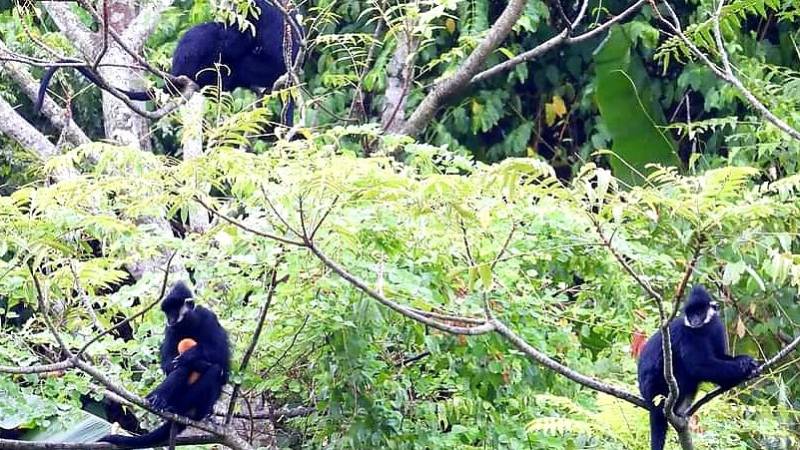
Fauna
The forests of Quảng Bình, particularly in Phong Nha-Kẻ Bàng, are home to at least 98 families, 256 genera and 381 species of vertebrates. 66 animal species are listed in Vietnam's Red Data Book and 23 other species in the World Red Book of Endangered Species. In 2005, a new species of skink (Lygosoma boehmeiwas) was discovered here by a group of Vietnamese biologists together with biologists working for the park, Cologne Zoo in Germany and the Saint Petersburg Wild Zoology Institute in Russia.
The gaur and one species of eel have been discovered in this park.10 new species previously unknown in Vietnam were discovered by scientists in the park. Phong Nha-Kẻ Bàng is home as well to a significant population of primates in Vietnam, with ten species and subspecies. These include the globally vulnerable pig-tailed macaque, Assam macaque, stump-tailed macaque and white-cheeked crested gibbon (Nomascus leucogenys and Nomascus leucogenys siki). The park is home to one of the largest populations of François' langur in Vietnam, including two different forms of the species. The area is known for its population of Hatinh and black langurs. 10 species of bats listed in the IUCN List of Threatened Species are recorded in this park. Of the 59 recorded reptile and amphibian species, 18 are listed in Vietnam's Red Data Book and 6 are listed in the IUCN Red List of Threatened Animals. The 72 fish species include 4 species endemic to the area, including Danio quangbinhensis.
The park is home to over 200 bird species, including such rare birds as the chestnut-necklaced partridge, red-collared woodpecker, brown hornbill, sooty babbler and the short-tailed scimitar babbler. An initiative survey conducted by Russian and Vietnamese scientists from Vietnam-Russia Tropical Centre (funded by WWF) recorded 259 butterfly species of 11 families. Almost all major butterfly taxa in Vietnam can be found in Phong Nha-Kẻ Bàng
